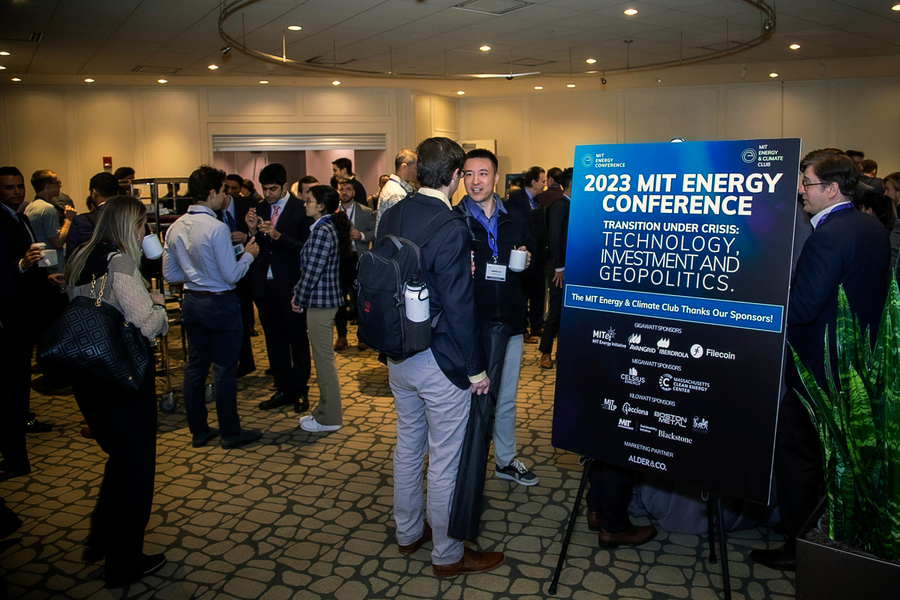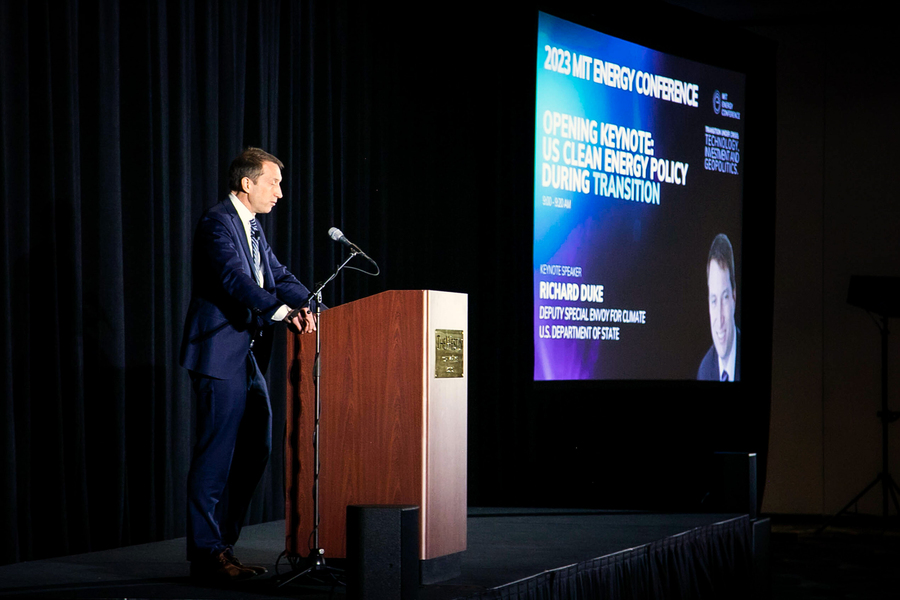As Russia’s war in Ukraine rages on, this year’s MIT Energy Conference spotlighted the role of geopolitics in the world’s efforts to lower greenhouse gas emissions and mitigate the worst effects of climate change.
Each year, the student-run conference, which its organizers say is the largest of its kind, brings together leaders from around the globe to discuss humanity’s most pressing energy and sustainability challenges.
The event always involves perspectives from the investment, business, research, and startup communities. But this year, as more than 600 attendees gathered on April 11 and 12 for a whirlwind of keynote talks, fireside chats, and panel discussions, common themes also included the influence of Russia’s war, rising tensions between the U.S. and China, and international collaboration.
As participants grappled with the evolving geopolitical landscape, some speakers encouraged moving past isolationist tendencies.
“Some people push for self-sufficiency, others emphasize that we should not rely on trading partners that don’t share our values — I think both arguments are misguided,” said Juan Carlos Jobet, Chile’s former ministry of energy and mining. “No country has all that’s needed to create an energy system that’s affordable, clean, and secure. … A third of the world’s energy output is generated in nondemocratic countries. Can we really make our energy systems affordable and secure and curb climate change while excluding those countries from our collective effort? If we enter an era of protectionism and disintegration, we will all be worse off.”
Another theme was optimism, such as that expressed by Volodymyr Kudrytskyi, CEO of Ukraine’s national power company, who spoke to the conference live from Kyiv. Kudrytskyi outlined Russia’s attacks on Ukraine’s power grids, which included more than 1,000 heavy missiles, making it the largest-ever campaign against a country’s power grid.
Still, Kudrytskyi said he was confident he’d be able to attend the conference in person next year. As it happened, Kudrytskyi’s presentation marked the day Ukraine resumed its energy exports to other countries.
“The good news is, after all of that, our system survived and continues operations,” he said.
Energy security and the green transition
Richard Duke, the U.S. Department of State’s deputy special envoy for climate, opened the conference with a keynote centered on the U.S.’ role in the global shift toward cleaner energy. Duke was among those advocating for a more integrated and diversified global energy system, noting that no country can address climate change on its own.
“We need to do all of these things in parallel, in concert with other governments, and through the architecture of the Paris Climate agreement that wraps it together in ambitious net greenhouse gas abatement targets,” Duke said.
Following his talk, Ditte Juul Jørgensen, the European Commission’s director general for energy, discussed the shift in the EU’s energy policies spurred by the Russian invasion of Ukraine.
She admitted the EU had grown too dependent on Russian natural gas, but said the invasion forced European states to revise their energy strategy while keeping their long-term objective of net neutrality by 2050.
“We see energy security and the green transition as interlinked. There is no energy security without the energy transition toward climate neutrality, and there’s no energy transition without energy security,” Jorgensen said.
Jørgensen also outlined steps the EU has taken to improve its energy security over the last year, including rolling out additional renewable energy projects and replacing Russian fuel with fuel from the U.S., which has now become the continent’s main supplier of energy.
“The fight against climate change is our shared ambition, it’s our shared responsibility, and I think we’ve shown over these last few years that we can turn that ambition into action and bring results,” she said.
A challenge and an opportunity
Optimism also shone through in the way speakers framed the green energy transition as a business opportunity. In keeping with the idea, the conference included a showcase of more than 30 startups focused on clean energy and sustainability.
“We’re all battling a huge problem that needs a collective effort,” said Malav Sukhadia of Sol Clarity, a conference exhibitor that uses electricity to clean solar panels as a way to replace water cleaning. “This is one of the best energy conferences in the world. We felt if you’re in climate tech, you have to be here.”
Technological development was a pillar of the conference, and a big topic in those discussions was green hydrogen, a clean fuel source that could replace natural gas in a number of applications and be produced using renewable energy. In one panel discussion on the technology, Sunita Satyapal of the Department of Energy noted the agency has been funding hydrogen development since the 1970s. Other panel members also stressed the maturity of the technology.
“A lot of the technology needed to advance the ecosystem exists now,” said Laura Parkan, vice president of hydrogen energy at Air Liquide Americas. “The challenge is to get things to a large enough scale so that the costs come down to make it more affordable and really advance the hydrogen ecosystem.”
Still, panel members acknowledged more technological development is needed to leverage the full potential of hydrogen, such as better mechanisms for storage and transportation.
Other advanced technologies mentioned in panel discussions included advanced geothermal energy and small modular nuclear reactors that could be built and deployed more quickly than conventional reactors.
“Exploring these different technologies may actually get us to the net zero — or even a zero carbon future — that we’re hoping for in electricity generation,” said Emma Wong of the OECD Nuclear Energy Agency, noting there are more than 80 advanced reactor designs that have been explored around the world. “There are various challenges and enabling conditions to be addressed, but places like China and Russia are already building these things, so there’s not a technological barrier.”
“Glass half full”
Despite the tall tasks that lie ahead, some speakers took a moment to celebrate accomplishments thus far.
“It’s incredible to think about the progress we’ve made in the last 10 years,” said Neil Brown of the KKR investment firm, whose company is working to build a large offshore wind project. “Solar and wind and electric vehicles have gone from impossibly expensive and hard to imagine penetrating the market to being very close to, if not already at, cost parity. We’ve really come an awful long way.”
Other speakers mixed their positivity with a confession of envy for the opportunity ahead of the young people in the audience, many of them students from MIT.
“I have a mix of excitement from the speakers we’ve heard so far and a little bit of envy as well for the open road the young students and professionals here have in front of them,” said Jobert. “Coming back to this place has made me reconnect with the sense of opportunity and responsibility that I felt as a student.”
Jobert offered lessons learned from his country’s struggles with an energy crisis, populist policies, and severe droughts. His talk finished with questions that struck at the heart of the conference.
“The evidence is clear: The Earth will change. How much is still to be decided,” Jobert said. “The energy sector has been a central part of the problem. We now must work to become an essential pierce of the solution. Where should we focus our efforts? What can we learn from each other?”














